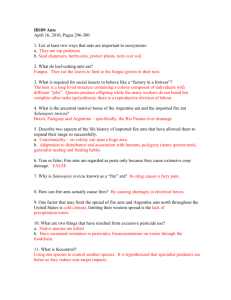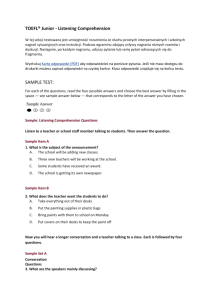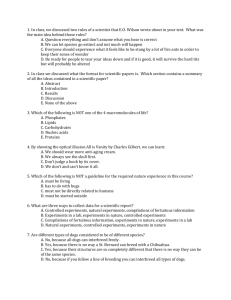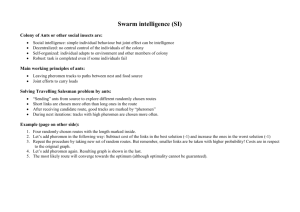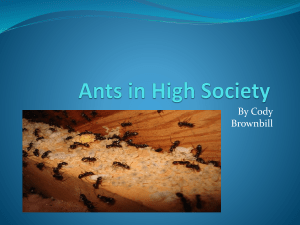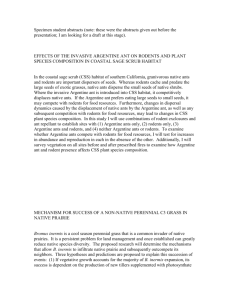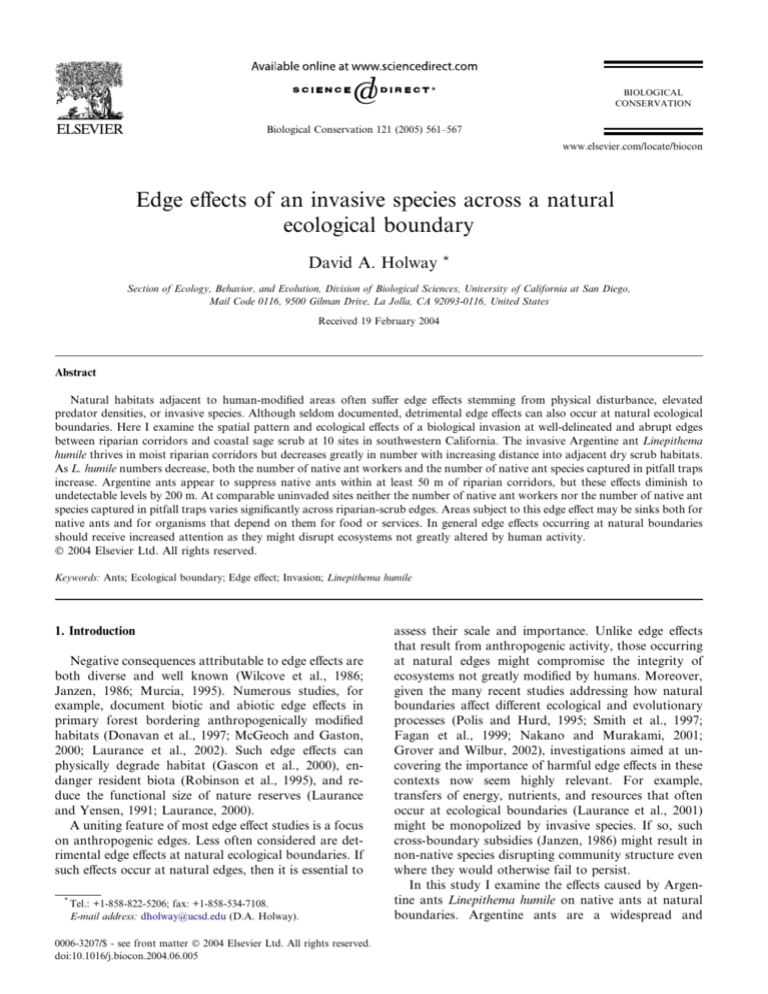
BIOLOGICAL
CONSERVATION
Biological Conservation 121 (2005) 561–567
www.elsevier.com/locate/biocon
Edge effects of an invasive species across a natural
ecological boundary
David A. Holway
*
Section of Ecology, Behavior, and Evolution, Division of Biological Sciences, University of California at San Diego,
Mail Code 0116, 9500 Gilman Drive, La Jolla, CA 92093-0116, United States
Received 19 February 2004
Abstract
Natural habitats adjacent to human-modified areas often suffer edge effects stemming from physical disturbance, elevated
predator densities, or invasive species. Although seldom documented, detrimental edge effects can also occur at natural ecological
boundaries. Here I examine the spatial pattern and ecological effects of a biological invasion at well-delineated and abrupt edges
between riparian corridors and coastal sage scrub at 10 sites in southwestern California. The invasive Argentine ant Linepithema
humile thrives in moist riparian corridors but decreases greatly in number with increasing distance into adjacent dry scrub habitats.
As L. humile numbers decrease, both the number of native ant workers and the number of native ant species captured in pitfall traps
increase. Argentine ants appear to suppress native ants within at least 50 m of riparian corridors, but these effects diminish to
undetectable levels by 200 m. At comparable uninvaded sites neither the number of native ant workers nor the number of native ant
species captured in pitfall traps varies significantly across riparian-scrub edges. Areas subject to this edge effect may be sinks both for
native ants and for organisms that depend on them for food or services. In general edge effects occurring at natural boundaries
should receive increased attention as they might disrupt ecosystems not greatly altered by human activity.
Ó 2004 Elsevier Ltd. All rights reserved.
Keywords: Ants; Ecological boundary; Edge effect; Invasion; Linepithema humile
1. Introduction
Negative consequences attributable to edge effects are
both diverse and well known (Wilcove et al., 1986;
Janzen, 1986; Murcia, 1995). Numerous studies, for
example, document biotic and abiotic edge effects in
primary forest bordering anthropogenically modified
habitats (Donavan et al., 1997; McGeoch and Gaston,
2000; Laurance et al., 2002). Such edge effects can
physically degrade habitat (Gascon et al., 2000), endanger resident biota (Robinson et al., 1995), and reduce the functional size of nature reserves (Laurance
and Yensen, 1991; Laurance, 2000).
A uniting feature of most edge effect studies is a focus
on anthropogenic edges. Less often considered are detrimental edge effects at natural ecological boundaries. If
such effects occur at natural edges, then it is essential to
*
Tel.: +1-858-822-5206; fax: +1-858-534-7108.
E-mail address: dholway@ucsd.edu (D.A. Holway).
0006-3207/$ - see front matter Ó 2004 Elsevier Ltd. All rights reserved.
doi:10.1016/j.biocon.2004.06.005
assess their scale and importance. Unlike edge effects
that result from anthropogenic activity, those occurring
at natural edges might compromise the integrity of
ecosystems not greatly modified by humans. Moreover,
given the many recent studies addressing how natural
boundaries affect different ecological and evolutionary
processes (Polis and Hurd, 1995; Smith et al., 1997;
Fagan et al., 1999; Nakano and Murakami, 2001;
Grover and Wilbur, 2002), investigations aimed at uncovering the importance of harmful edge effects in these
contexts now seem highly relevant. For example,
transfers of energy, nutrients, and resources that often
occur at ecological boundaries (Laurance et al., 2001)
might be monopolized by invasive species. If so, such
cross-boundary subsidies (Janzen, 1986) might result in
non-native species disrupting community structure even
where they would otherwise fail to persist.
In this study I examine the effects caused by Argentine ants Linepithema humile on native ants at natural
boundaries. Argentine ants are a widespread and
562
D.A. Holway / Biological Conservation 121 (2005) 561–567
abundant invasive species (Holway et al., 2002a). In
many parts of the world L. humile invades natural environments (Suarez et al., 2001) and displaces native
ants (Erickson, 1971; Bond and Slingsby, 1984; Ward,
1987; Human and Gordon, 1996; Cammell et al., 1996;
Carpintero et al., 2004). In California mesic riparian
woodlands support high densities of Argentine ants and
serve as corridors of dispersal (Tremper, 1976; Ward,
1987; Holway, 1998a); Argentine ants almost entirely
displace native ants from these habitats (Ward, 1987;
Holway, 1998b). Chaparral and coastal sage scrub, in
contrast, are usually too dry to support L. humile. These
habitats become invaded primarily where fragmented
and irrigated by urban runoff (Suarez et al., 1998; Holway et al., 2002b) or in coastal areas where summer fog
ameliorates the summer drought. At riparian-scrub
edges, however, Argentine ants may invade otherwise
unsuitable scrub habitat because of its juxtaposition
with riparian woodland. Here I examine the spatial scale
of this edge effect and its impact on native ants at replicate sites distributed across a large geographic area.
2. Methods
This study included five replicate pairs of riparian –
scrub boundaries in southwestern San Diego County,
California (Fig. 1). Each pair of sites was located along
the same river or creek and included one site invaded by
Argentine ants and one otherwise similar site that still
supported native ants (Fig. 1). All sites were located
away from urban development, situated inside protected
federal, state, or county preserves, and connected to
large, unfragmented ecosystems. The habitats at each
site were natural in the sense that they contained common native perennial plants typical of the region and
were not altered much by human activity. Within each
watershed I matched sites for habitat, aspect, and slope.
N
San Dieguito R
N 33.2
~
Los Penasquitos
Cr
Pacific
Ocean
N 32.8
15 km
San Diego R
Sweetwater R
W 117.4
Otay R
tes
United Sta
Mexico
W 117.0
Fig. 1. Map of study sites in southwestern California. Open circles are
sites that lack Argentine ants; closed circles are invaded sites.
Invaded and uninvaded sites did not differ, on average,
in their proximity to the coast (Invaded: 21 3 km,
Uninvaded: 24 6 km (mean ( 1 SE))), elevation (Invaded: 98 18 m, Uninvaded: 103 26 m), or distance
to nearest paved road (Invaded: 0.52 0.13 km, Uninvaded: 0.40 0.10 km). Sites within each watershed were
on average 8 km apart. Given the geographical scope of
the sampling effort, the perennial flora varied somewhat
from drainage to drainage, but all sites exhibited the
following similarities. Riparian corridors varied in width
from 50 to 100 m and were composed of Salix spp.,
Populus fremontii, Platanus racemosa, and Quercus agrifolia. Outside of river corridors, lush riparian vegetation always gave way abruptly (i.e., within a few meters
at all 10 sites) to open formations of xeric coastal sage
scrub consisting primarily of Artemisia californica, Eriogonum fasciculatum, Malosma laurina, Salvia mellifera,
and S. apiana.
The sites described above can be classified as either
invaded or uninvaded (Fig. 1) because Argentine ants
exhibit inherently limited powers of dispersal. Unlike
ants with winged dispersal of gynes, colonies of L. humile appear to reproduce only by budding (Newell and
Barber, 1913). This mode of dispersal constrains the rate
of spread to around 100 m yr1 in suitable habitat and
prevents jump-dispersal of propagules ahead of invasion
fronts (Suarez et al., 2001). Because of these limited
dispersal capabilities and the vagaries of human introduction, it is common for riparian corridors, such as
those included in this study, to contain invaded and
uninvaded sections (Tremper, 1976; Ward, 1987; Holway, 1995). Based on the Argentine ant’s dispersal limitations and its local distribution in the areas
surrounding invaded sites in this study, this species has
probably been present for a minimum of several years at
each of the five invaded sites (and probably for longer).
Several lines of evidence suggest that uninvaded sites are
all at risk of being invaded eventually: (1) uninvaded
sites are directly connected to invaded sites via continuous riparian vegetation, (2) Argentine ants are advancing along riparian corridors at all five invaded sites,
and (3) riparian habitat at uninvaded sites appears to be
suitable to Argentine ants.
At each of the 10 sites shown in Fig. 1 I used pitfall
traps to sample ants along a transect spanning riparianscrub edges. Pitfalls are a commonly used and effective
method to sample ants (Porter and Savignano, 1990;
Suarez et al., 1998; Holway, 1998b; Morrison, 2002;
Morrison and Porter, 2003). This is especially true for
coastal sage scrub, where techniques such as leaf-litter
sampling and dead wood inspection would be of little
use given that ants from this habitat seldom nest in the
sparse leaf litter or in twigs. At each site I established a
linear, 200-m transect originating at and oriented perpendicular to the riparian corridor. On each transect I
placed a set of five traps at each of four distances from
D.A. Holway / Biological Conservation 121 (2005) 561–567
3. Results
Argentine ants were extremely common in pitfalls at
all five invaded riparian corridors but decreased sharply
in abundance with increasing distance into the coastal
sage scrub (Fig. 2(a)). Argentine ants were captured 100
m away from riparian corridors at all five invaded sites
log10 (workers/trap)
(a) 3
Argentine ants
2
1
Native ants
(b)
log10 (workers/trap)
the edge of the riparian corridor: 25, 50, 100, and 200 m.
I also placed a set of traps inside each riparian corridor;
these sets are referred to as 0-m traps. For each distance
category, I placed the individual traps within a set approximately 10 m apart in an irregular line parallel to
the riparian corridor. Each trap consisted of a 50 ml,
plastic centrifuge tube buried with the rim flush with the
level of the soil. All traps contained 30 ml of a non-toxic
dilute saline-detergent solution (Burger et al., 2001). I
left traps in the ground for five days during each of three
sampling periods (May 2002, July 2002, September
2002). The total sampling effort was 750 pitfalls. About
3% of all traps were dug up by mammals, but trap loss
was distributed fairly evenly across site x distance categories such that each category received an approximately equivalent level of sampling. After I removed
traps from the field I sorted ants from non-ants and
placed samples in 95% ethanol. I identified ants to species and deposited voucher specimens in the Bohart
Museum of Entomology, University of California, Davis (UCDC). In a recent study also conducted in San
Diego, Suarez et al. (1998) found that the approximate
level of sampling employed here was sufficient to detect
a majority of ant species within sites similar in size to
those included in this study.
I used split-plot analysis of variance (ANOVA) to
compare invaded and uninvaded sites with respect to the
number of native ant species and the number of native
ant workers. There were two main effects in each ANOVA: (1) status (invaded and uninvaded), and (2) distance away from the edge of the riparian corridor (0, 25,
50, 100, and 200 m). Status was a whole-plot effect;
distance was a split-plot effect. Blocks of sites were
random effects; status and distance were treated as fixed
effects. For the ANOVA with the number of native ant
species as the dependent variable, I used cumulative
species counts for each site x distance category as data
points. In the ANOVA with worker abundance in pitfalls as the dependent variable, for each site x distance
category, I calculated the number of native ant workers
captured per trap and averaged these values across the
three sampling periods. I used these means (log10 transformed) as data points. Note that abundance estimates reflect above-ground activity during sampling
periods; these estimates may be uncorrelated with colony density. I performed all statistical tests using SYSTAT, Version 5.2.1.
563
1.4
1.2
1.0
0.8
0.6
0.4
0.2
0
25
50 100 200
Distance away from riparian corridor (m)
Fig. 2. Mean ( 1 SE) abundance of (a) Argentine ants and (b) native
ants captured in pitfalls at 10 riparian-scrub edges. Open circles are
sites that lack Argentine ants (n ¼ 5); closed circles are invaded sites
(n ¼ 5).
but reached 200 m at only one site (Table 1). Consistent
with the dispersal limitations of this species, no Argentine ants were recorded from uninvaded sites (Table 1).
Abundance of native ants in pitfalls across the riparian –
scrub edge depended strongly on the presence of Argentine ants (Fig. 2(b); split-plot ANOVA, status x
distance interaction: F4;32 ¼ 4:40, p ¼ 0:006). Native ant
abundance in pitfalls increased linearly with distance
away from the corridor at invaded sites (Fig. 2(b); linear
contrast: F1;32 ¼ 11:81, p ¼ 0:002), whereas no significant relationship existed between distance and abundance in pitfalls at uninvaded sites (Fig. 2(b); linear
contrast: F1;32 ¼ 2:142, p ¼ 0:153). Compared to uninvaded sites, invaded sites supported fewer native ants
(Fig. 2(b); split-plot ANOVA: F1;4 ¼ 8:58, p ¼ 0:041),
but this was due primarily to low abundance in the first
three distance categories. By 200 m, the numbers of
native ants in pitfalls at invaded sites were similar to
those from uninvaded sites (Fig. 2(b)).
As with native ant abundance, the number of native
ant species captured in pitfalls across the riparian –
scrub edge depended strongly on the presence of Argentine ants (Fig. 3; split-plot ANOVA, status x distance
interaction: F4;32 ¼ 7:70, p < 0:0005). The number of
native ant species detected increased linearly with distance away from the riparian corridor at invaded sites
(Fig. 3; linear contrast: F1;32 ¼ 24:98, p < 0:0005),
whereas no significant relationship existed between distance and the number of native ant species in pitfalls at
uninvaded sites (Fig. 3; linear contrast: F1;32 ¼ 0:47,
p ¼ 0:500). Compared to uninvaded sites, invaded sites
564
D.A. Holway / Biological Conservation 121 (2005) 561–567
Table 1
Ants recorded at riparian-scrub edges
Status
Invaded
Uninvaded
Distance
0
25
50
100
200
0
25
50
100
200
Subfamily Ponerinae
Hypoponera opacior
Hypoponera opaciceps
1
0
0
0
0
0
1
0
0
0
1
1
0
0
0
0
0
0
0
0
Subfamily Dolichoderinae
Dormyrmex insanus
Forelius mccooki
Linepithema humile
Liometopum occidentale
Tapinoma sessile
0
0
5
0
0
0
0
5
0
0
0
2
5
0
0
1
1
5
0
0
1
5
1
0
1
1
2
0
3
5
1
4
0
0
1
2
4
0
0
0
0
3
0
0
0
0
4
0
0
0
Subfamily Formicinae
Camponotus dumetorum
Camponotus sp. cf. semitestaceus
Camponotus vicinus
Formica francoeuri
Formica moki
Myrmecocystus wheeleri
Paratrechina sp. cf. terricola
Prenolepis imparis
0
0
0
0
0
0
0
0
0
0
0
0
0
0
0
0
0
0
0
0
0
0
0
0
1
0
1
0
1
0
0
0
1
0
0
0
0
0
0
0
0
3
0
1
1
0
0
1
0
1
0
1
0
0
0
0
0
0
0
1
0
0
0
0
0
0
0
1
0
0
0
0
0
0
0
0
1
1
1
0
Subfamily Myrmicinae
Cardiocondyla mauritanica
Crematogaster californica
Crematogaster hespera
Cyphomyrmex wheeleri
Messor andrei
Monomorium ergatogyna
Pheidole californica
Pheidole cerebrosior
Pheidole clementensis
Pheidole hyatti
Pheidole pilifera
Pheidole vistana
Pogonomyrmex californicus
Pogonomyrmex rugosus
Solenopsis amblychila
Solenopsis molesta
Solenopsis xyloni
Stenamma sp. cf. punctatoventre
Temnothorax andrei
Tetramorium spinosum
0
0
0
0
0
0
0
0
0
0
0
0
0
0
0
2
0
1
3
0
1
1
0
0
0
0
1
2
2
0
0
0
0
0
0
2
0
0
2
0
0
2
0
0
0
0
0
1
2
0
0
0
0
0
0
0
2
0
2
0
0
2
0
0
0
1
0
0
2
0
0
4
0
0
1
0
2
0
3
1
0
5
0
0
0
1
0
0
1
0
0
5
0
0
1
2
4
0
2
3
1
1
3
0
0
1
0
0
0
1
0
1
1
1
1
2
1
0
1
0
0
2
1
2
0
0
0
2
0
0
0
4
2
1
2
3
5
0
3
1
0
1
0
1
1
0
0
2
1
0
0
4
1
1
1
1
4
0
5
2
0
4
0
2
0
0
0
2
2
0
1
4
0
1
0
1
1
0
2
1
0
5
0
1
0
1
0
2
0
0
0
5
0
1
1
1
1
0
2
2
Richness of native ants
Table entries refer to number of sites (out of 5) that each species was recorded in each distance category. Distances refer to meters away from
riparian corridors. Non-native species are in bold type.
8
7
6
5
4
3
2
1
0
25
50 100 200
Distance away from riparian corridor (m)
Fig. 3. Mean ( 1 SE) number of native ant species captured in pitfalls
at 10 riparian-scrub edges. Open circles are sites that lack Argentine
ants (n ¼ 5); closed circles are invaded sites (n ¼ 5).
supported fewer native ant species (Fig. 3; split-plot
ANOVA: F1;4 ¼ 10:07, p ¼ 0:034), but this was due to
depressed diversity in the first three distance categories.
At both 100 and 200 m, the number of native ant species
detected at invaded sites had risen to levels similar to
those recorded in these same distance categories at uninvaded sites.
Above-ground foraging native ants were most affected by Argentine ants. Inside invaded riparian corridors the only native ants detected were litter-dwelling
and below-ground foraging species: Temnothorax anderi, Solenopsis molesta, Hypoponera opacior, and
Stenamma sp. cf. punctatoventre (Table 1). Above-
D.A. Holway / Biological Conservation 121 (2005) 561–567
(Abundance invaded site) >
(Abundance uninvaded site)
Forelius
4 mccooki
3
Solenopsis
xyloni
2
1
Pheidole
4 vistana
3
Crematogaster
californica
2
1
25 50 100 200 25 50 100 200
Distance away from riparian corridor (m)
Fig. 4. Relative susceptibility of native ants to displacement by Argentine ants. Height of each bar corresponds to the number of cases
(out of 5) that the abundance of a native ant species at an invaded site
exceeded its abundance at a paired, uninvaded site. Sites are paired
with respect to watershed and distance category. The four native ants
included were the most common and widespread omnivorous and
above-ground foraging species detected in scrub habitats.
ground foraging species, such as Liometopum occidentale, Camponotus sp. cf. semitestaceus, Tapinoma sessile,
and Crematogaster hespera, were common in uninvaded
riparian corridors but were entirely absent from invaded
ones. Outside of invaded riparian corridors, in the scrub
areas most affected by Argentine ants (e.g., 25 and 50 m
distance categories), above-ground foraging native ants
were largely absent, even though they were common
beyond 100 m at invaded sites and at all distance categories at uninvaded sites (Table 1). Notable among these
absences were ecologically important harvester ants
(e.g., Pogonomyrmex spp.). Of the four most common
and widespread omnivorous native ants detected in
scrub habitats, Solenopsis xyloni, Forelius mccooki, and
Pheidole vistana all appeared highly susceptible to displacement by Argentine ants, whereas no clear pattern
was evident for Crematogaster californica (Fig. 4 and
Table 1).
4. Discussion
This study provides an empirical example of an edge
effect produced by an invasive species at a natural ecological boundary. At multiple sites spread across a large
area (Fig. 1), invaded riparian corridors appeared to
promote the local spread of Argentine ants into coastal
sage scrub, a habitat type usually unsuitable to L. humile
(Suarez et al., 1998; Holway et al., 2002b). Argentine
ants attained maximum abundance inside riparian corridors, and native ants were almost entirely absent from
these sites (Figs. 2,3 and Table 1). With increasing distance away from invaded corridors, L. humile numbers
declined dramatically and monotonically (Fig. 2(a)),
while the number of native ant workers (Fig. 2(b)) and
565
the number of native ant species (Fig. 3) captured in
pitfalls increased steadily. The decline of Argentine ants
with increasing distance from invaded riparian corridors
(Fig. 2(a)) qualitatively matches that reported for anthropogenic moisture gradients found at edges between
well-watered urban areas and dry scrub habitats elsewhere in southern California (Suarez et al., 1998; Bolger
et al., 2000; Holway et al., 2002b). Unlike those previous
studies, however, the pattern shown in Fig. 2(a) seems
unlikely to have resulted from a gradient in anthropogenic disturbance. All sites were located away from urban development, situated inside protected areas, and
embedded in large, unfragmented tracts of coastal sage
scrub and chaparral. Evidence that invaded and uninvaded sites were well matched (in respects other than the
presence or absence of Argentine ants) comes from Figs.
2 and 3. Both the number of native ant workers
(Fig. 2(b)) and the number of native ant species (Fig. 3)
captured in pitfalls were strikingly similar between invaded and uninvaded sites in the 200 m distance
category.
Invaded riparian corridors might be subsidizing the
invasion of Argentine ants into drier scrub habitats,
which would otherwise not support colonies of this
species. Both abiotic and biotic factors could contribute
to this effect. Soil moisture, for example, appears to
govern the distribution (Tremper, 1976; Ward, 1987),
abundance (Holway et al., 2002b), and rate of spread
(Holway, 1998a) of Argentine ants in the seasonally dry
habitats of California. Compared to ants native to interior and southern California, Argentine ants more
readily succumb to aridity and thermal stress (Tremper,
1976; Holway et al., 2002b). Because of these physiological constraints and because Argentine ants do not
nest very deeply underground, they remain largely
confined to areas with adequate levels of superficial soil
moisture. For this reason, mesic riparian woodlands in
California represent excellent habitat. Riparian corridors may also provide important food resources. For
Argentine ants, a key resource may be honeydew-excreting insects, such as aphids and scales (Newell and
Barber, 1913). Riparian corridors support large aggregations of these insects (personal observation), which
may enable L. humile to persist at high densities, as has
been found for other ant species that exploit honeydewexcreting insects (Davidson et al., 2003).
Coastal sage scrub sites in this study became invaded
only when in close proximity to invaded riparian corridors. Opportunistic and somewhat nomadic in its nesting behavior (Newell and Barber, 1913), L. humile
forage and nest in near-corridor scrub areas under
suitable abiotic conditions (e.g., at night or in winter
and early spring when soils remain moist from winter
rains), but mostly desert these areas when conditions
become unfavorable (personal observation). Seasonal
relocation along a moisture gradient was noted by
566
D.A. Holway / Biological Conservation 121 (2005) 561–567
Markin (1970) who observed Argentine ants in southern
California nesting on a scrub covered hillside adjacent to
a citrus orchard during winter only to abandon it in
favor of the shadier orchard during summer. An alternative hypothesis for the Argentine ant’s limited ability
to penetrate scrub (Fig. 2(a); see also Holway et al.,
2002b) could involve biotic resistance in the form of
interspecific competition from native ants. However, at
the uninvaded sites in this study neither the number of
native ant workers nor the number of native ant species
captured in pitfalls varied significantly across riparianscrub edges (Figs. 2(b) and 3). Assuming invaded sites
exhibited a similar pattern prior to invasion, riparian
and scrub habitats at these sites might have offered
comparable levels of biotic resistance.
Although this study is the first to demonstrate statistically the effects of Argentine ant invasions at natural
boundaries, previous studies have commented on analogous phenomena. At a site in central California, for
example, Kennedy (1998) found that Argentine ants
were common in a riparian corridor and in adjacent
coastal sage scrub (growing on one side of a creek) but
were absent from adjacent chaparral (growing on the
opposite side of the creek). Because Kennedy (1998)
conducted his study at the leading edge of a single invasion front, however, it is difficult to know whether this
pattern reflects static distributional limits or whether
Argentine ants simply had not yet invaded unoccupied
areas. In southern Portugal Way et al. (1997) found
Argentine ants in areas with sand and clay loam soils
but not in areas with sandy loam soils associated with
metamorphic rocks. The mechanism underlying this
association is not known (Way et al., 1997). The strong
signal of soil moisture observed in the present study may
be a result of San Diego’s more arid climate, which
averages only 250 mm annual rainfall.
The edge effect documented in this study may well
transform riparian-scrub edges into sinks not only for
native ants but also for organisms that depend on them
for food or services. Argentine ants apparently eliminated or greatly reduced nearly all ant species within 50
m of riparian corridors. It seems likely that the replacement of this native ant community by a single, nonnative species will give rise to a variety of direct and
indirect ecological effects. The loss of large bodied harvester ants (e.g., Pogonomymex and Messor), for example, may well ramify throughout the community to
affect plants that depend on these ants to disperse their
seeds (Carney et al., 2003) and vertebrates that rely on
them for food (Suarez and Case, 2002). These results
imply that riparian reserves may be susceptible to species loss both inside and outside of the riparian corridor
unless they are bordered by a sufficient buffer zone of
upland habitat.
The importance of edge effects caused by invasive
species at natural ecological boundaries generally de-
serves further scrutiny, perhaps especially in cases that
involve resource subsidies. In such situations strongly
competitive invasive species may not only dominate
native species in source habitats but also in habitats that
are unsuitable for the invader in the absence of the
subsidy (see also Maurer and Zedler, 2002). Such spatially subsidized exclusion of native species could lead to
important and unforeseen ecological effects outside of
the main areas of invasion. A subsidized invader, for
example, might disrupt ecological communities in sink
habitats where it is present only intermittently.
Acknowledgements
The following reserve managers granted access to
study sites: L. Charett (San Dieguito River Park/Santa
Ysabel Creek), J. DeAngelis (Los Pe~
nasquitos Canyon
Preserve), P. Kilberg (Mission Trails Regional Park), B.
Lipowkan (Otay Valley Regional Park), J. Lopez (San
Dieguito River Park), and V. Urban (San Diego National Wildlife Refuge). E. Caldera, J. Cost, J. Giordano, E. Goldberg, S.B. Menke, B. Pister, L. Sanchez, P.
Schilman, and J. Williams helped with fieldwork. J.C.
Burger suggested the design of the pitfall traps. L.
Sanchez assisted with preparation of voucher specimens.
P.S. Ward and A.V. Suarez helped with ant identification. D.H. Feener, Jr. provided invaluable advice on the
statistical analysis. S.E. Carney, T.J. Case, K.R. Crooks,
D.H. Feener, A.D. Kay, P. Krushelnycky, L. Lach, R.
Lande, S.B. Menke, T. Miller, M.L. Thomas, A.V. Suarez, P.S. Ward, and several anonymous reviewers offered useful comments on the manuscript.
References
Bolger, D.T., Suarez, A.V., Crooks, K.R., Morrison, S.A., Case, T.J.,
2000. Arthropods in urban habitat fragments in southern California: area, age and edge effects. Ecological Applications 10, 1230–
1248.
Bond, W., Slingsby, P., 1984. Collapse of an ant-plant mutualism – the
Argentine Ant (Iridomyrmex humilis) and myrmecochorous Proteaceae. Ecology 65, 1031–1037.
Burger, J.C., Patten, M.A., Prentice, T.R., Redak, R.A., 2001.
Evidence for spider community resilience to invasion by nonnative spiders. Biological Conservation 98, 241–249.
Cammell, M.E., Way, M.J., Paiva, M.R., 1996. Diversity and structure
of ant communities associated with oak, pine, eucalyptus and
arable habitats in Portugal. Insectes Sociaux 43, 37–46.
Carney, S.E., Byerley, M.B., Holway, D.A., 2003. Invasive Argentine
ants (Linepithema humile) do not replace native ants as seed
dispersers of Dendromecon rigida (Papaveraceae) in California,
USA. Oecologia 135, 576–582.
Carpintero, S., Reyes-Lopez, J., Arias de Reyna, L., 2004. Impact of
human dwellings on the distribution of the exotic Argentine ant: a
case study in the Do~
nana National Park, Spain. Biological
Conservation 115, 279–289.
Davidson, D.W., Cook, S.C., Snelling, R.R., Chua, T.H., 2003.
Explaining the abundance of ants in lowland tropical rainforest
canopies. Science 300, 969–972.
D.A. Holway / Biological Conservation 121 (2005) 561–567
Donavan, T.M., Jones, P.S., Annand, E.M., Thompson, F.R., 1997.
Variation in local-scale edge effects: mechanisms and landscape
context. Ecology 78, 2064–2075.
Erickson, J.M., 1971. The displacement of native ant species by the
introduced Argentine ant Iridomyrmex humilis Mayr. Psyche 78,
257–266.
Fagan, W.F., Cantrell, R.S., Cosner, C., 1999. How habitat edges
change species interactions. The American Naturalist 153, 165–182.
Gascon, C., Williamson, G.B., da Fonseca, G.A.B., 2000. Receding
forest edges and vanishing reserves. Science 288, 1356–1358.
Grover, M.C., Wilbur, H.M., 2002. Ecology of ecotones: interactions
between salamanders on a complex environmental gradient.
Ecology 83, 2112–2123.
Holway, D.A., 1995. The distribution of the Argentine ant (Linepithema humile) in northern California. Conservation Biology 9,
1634–1637.
Holway, D.A., 1998a. Factors governing rate of invasion: a natural
experiment using Argentine ants. Oecologia 115, 206–212.
Holway, D.A., 1998b. Effect of Argentine ant invasions on grounddwelling arthropods in northern California riparian woodlands.
Oecologia 116, 252–258.
Holway, D.A., Lach, L., Suarez, A.V., Tsutsui, N.D., Case, T.J.,
2002a. The causes and consequences of ant invasions. Annual
Review of Ecology and Systematics 33, 181–233.
Holway, D.A., Suarez, A.V., Case, T.J., 2002b. Role of abiotic factors
in governing susceptibility to invasion: a test with Argentine ants.
Ecology 83, 1610–1619.
Human, K.G., Gordon, D.M., 1996. Exploitation and interference
competition between the invasive Argentine ant, Linepithema
humile, and native ant species. Oecologia 105, 405–412.
Janzen, D.H., 1986. The eternal external threat. In: Soule, M.E. (Ed.),
Conservation Biology: the Science of Scarcity and Diversity.
Sinauer Associates Inc, Sunderland, MA, pp. 286–303.
Kennedy, T.A., 1998. Patterns of an invasion by Argentine ants
(Linepithema humile) in a riparian corridor and its effects on ant
diversity. American Midland Naturalist 140, 343–350.
Laurance, W.F., 2000. Do edge effects occur over large spatial scales?
Trends in Ecology and Evolution 15, 134–136.
Laurance, W.F., Yensen, E., 1991. Predicting the impacts of edge
effects in fragmented habitats. Biological Conservation 55, 77–92.
Laurance, W.F., Didham, R.K., Power, M.E., 2001. Ecological
boundaries: a search for synthesis. Trends in Ecology and
Evolution 16, 70–71.
Laurance, W.F., Lovejoy, T.E., Vasconcelos, H.L., Bruna, E.M.,
Didham, R.K., Stouffer, P.C., Gascon, C., Bierregaard, R.O.,
Laurance, S.G., Sampaio, E., 2002. Ecosystem decay of Amazonian forest fragments: a 22-year investigation. Conservation
Biology 16, 605–618.
Markin, G.P., 1970. Seasonal life cycle of the Argentine ant,
Iridomyrmex humilis, (Hymenoptera: Formicidae). Annals of the
Entomological Society of America 63, 1238–1242.
Maurer, D.A., Zedler, J.B., 2002. Differential invasion of a wetland
grass explained by tests of nutrients and light availability on
establishment and clonal growth. Oecologia 131, 279–288.
McGeoch, M.A., Gaston, K.J., 2000. Edge effects on the prevalence
and mortality factors of Phytomyza ilicis (Diptera, Agromyzidae)
in a suburban woodland. Ecology Letters 3, 23–29.
567
Morrison, L.W., 2002. Long-term impacts of an arthropod-community
invasion by the imported fire ant, Solenopsis invicta. Ecology 83,
2337–2345.
Morrison, L.W., Porter, S.D., 2003. Positive association between
densities of the red imported fire ant, Solenopsis invicta (Hymenoptera: Formicidae), and generalized ant and arthropod diversity.
Environmental Entomology 32, 548–554.
Murcia, C., 1995. Edge effects in fragmented forests: implications for
conservation. Trends in Ecology and Evolution 10, 58–62.
Nakano, S., Murakami, M., 2001. Reciprocal subsidies: dynamic
interdependence between terrestrial and aquatic food webs. Proceedings of the National Academy of Sciences USA 98,
166–170.
Newell, W., Barber, T.C., 1913. The Argentine ant. Bureau of
Entomology Bulletin, vol. 122. USDA, Washington, D.C., pp. 1–
98.
Polis, G.A., Hurd, S.D., 1995. Extraordinarily high spider densities on
islands: flow of energy from the marine to terrestrial food webs in
the absence of predation. Proceedings of the National Academy of
Sciences USA 92, 4382–4386.
Porter, S.D., Savignano, D.A., 1990. Invasion of polygyne fire ants
decimates native ants and disrupts arthropod community. Ecology
71, 2095–2106.
Robinson, S.K., Thompson, F.R., Donovan, T.M., Whitehead, D.R.,
Faaborg, J., 1995. Regional forest fragmentation and the nesting
success of migratory birds. Science 267, 1987–1990.
Smith, T.B., Wayne, R.K., Girmin, D., Bruford, M.W., 1997. A role
for ecotones in generating rainforest biodiversity. Science 276,
1855–1857.
Suarez, A.V., Case, T.J., 2002. Bottom-up effects on persistence of a
specialist predator: ant invasions and horned lizards. Ecological
Applications 12, 291–298.
Suarez, A.V., Bolger, D.T., Case, T.J., 1998. Effects of fragmentation
and invasion on native ant communities in coastal southern
California. Ecology 79, 2041–2056.
Suarez, A.V., Holway, D.A., Case, T.J., 2001. Patterns of spread in
biological invasions dominated by long-distance jump dispersal:
insights from Argentine ants. Proceedings of the National Academy of Sciences USA 98, 1095–1100.
Tremper, B.S., 1976. Distribution of the Argentine ant, Iridomyrmex
humilis Mayr, in relation to certain native ants of California:
ecological, physiological, and behavioral aspects. Ph.D. Thesis,
University of California at Berkeley.
Ward, P.S., 1987. Distribution of the introduced Argentine ant
(Iridomyrmex humilis) in natural habitats of the lower Sacramento
River Valley and its effects on the indigenous ant fauna. Hilgardia
55 (2), 1–16.
Way, M.J., Cammell, M.E., Paiva, M.R., Collingwood, C.A., 1997.
Distribution and dynamics of the Argentine ant Linepithema
(Iridomyrmex) humile (Mayr) in relation to vegetation, soil conditions, topography and native competitor ants in Portugal. Insectes
Sociaux 44, 415–433.
Wilcove, D.S., McLellan, C.H., Dobson, A.P., 1986. Habitat
fragmentation in the temperate zone. In: Soule, M.E. (Ed.),
Conservation Biology: the Science of Scarcity and
Diversity. Sinauer Associates Inc, Sunderland, MA, pp.
237–256.


